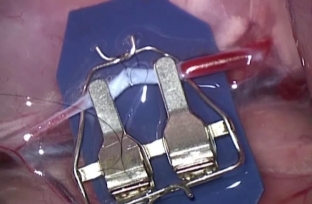Microvascular surgery – This is a direction in medicine that plastic surgeons often have to deal with. It is often necessary to work with vessels of small diameter when connecting the fingers of the hand, as well as when performing autotransplantation of skin flaps. An extremely important role for plastic surgeons is played by the technique of applying anastomoses between vessels. Quite often, manual seams are used for this purpose, which is a technically difficult job. About the features of the imposition of vascular anastomoses and manual sutures on the vessels estet-portal.com.
Principles of surgical technique for anastomosesAmong the various suture methods of anastomoses, there are two main types of sutures: manual and mechanical. Every year there are more and more new options for applying mechanical sutures, which, of course, are somewhat simpler. But the technique of a complex manual suture remains no less relevant and gives the best results when applying vascular anastomoses. The technique of manual suture was developed many years ago by the French surgeon A. Carrel and is successfully practiced by many plastic surgeons at the present time. Hand seam can be continuous and knotted, and each of these types has its own characteristics.
Anastomoses:
- features of anastomoses with manual sutures;
- end-to-end anastomosis technique;
- end-to-side anastomosis technique.
Continuous manual suture for anastomoses is mainly used to connect medium-sized arteries and veins, as it can lead to narrowing of the anastomosis itself. The technique for applying such a suture is as follows: the vessels are sutured with two fixation sutures at two points at an angle of 180°; around the circumference. The use of this technique reduces the risk of damage to the opposite wall of the vessel during the passage of the needle. An interrupted suture is very often used when directly applying microanastomoses. In this case, the number of stitches should be minimal, but ensure the tightness of the created anastomosis, and the suture thread should pass through all layers of the vessel wall.

End-to-end anastomosis is the simplest and most reliable way to connect vessels.This anastomosis can be applied in any situation and is well suited for connecting vessels of different calibers. When applying an anastomosis "end to side" important points to consider:
- vessels must not flex when in a double clamp;
- the first two sutures should be placed on opposite sides of the vessels, and the third – between support seams;
- after suturing the anterior wall of the vessel, the double clamp is rotated to expose the posterior wall, which is also sutured;
- all subsequent sutures can be applied without tying;
- To increase the diameter of the vessels to be sutured, their edges are cut at an oblique angle.
End-to-side anastomosis is used in vascular surgery when "off" recipient vessel can lead to severe ischemia of the tissues it supplies.The recipient vessel is clamped with two vascular clamps at a distance sufficient to sew in the donor vessel. Then, a lateral defect of the required size is cut out in the vessel. When blood flow is restored, distal and then proximal vascular clamps are first removed. This method of vascular anastomosis is widely used, for example, on the lower limb, when there is only one available vessel, or to create anastomoses in the head and neck.







Add a comment